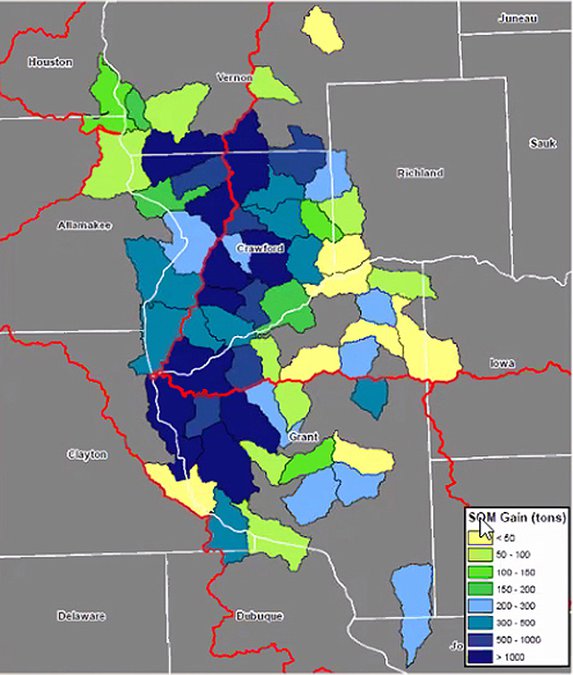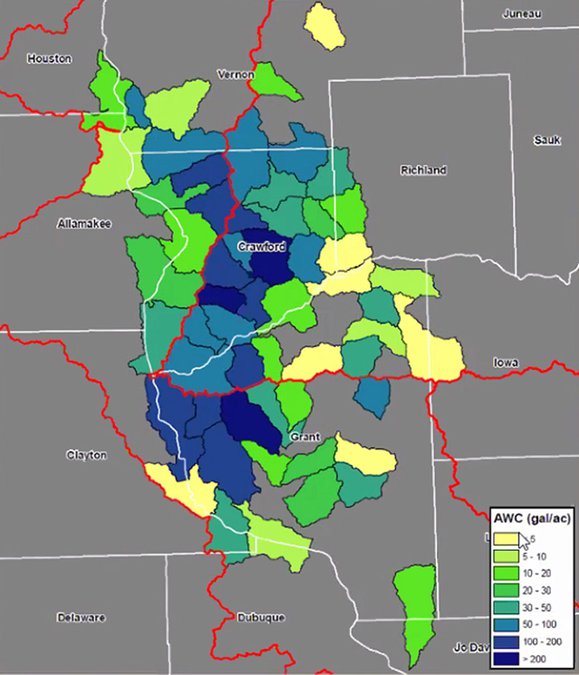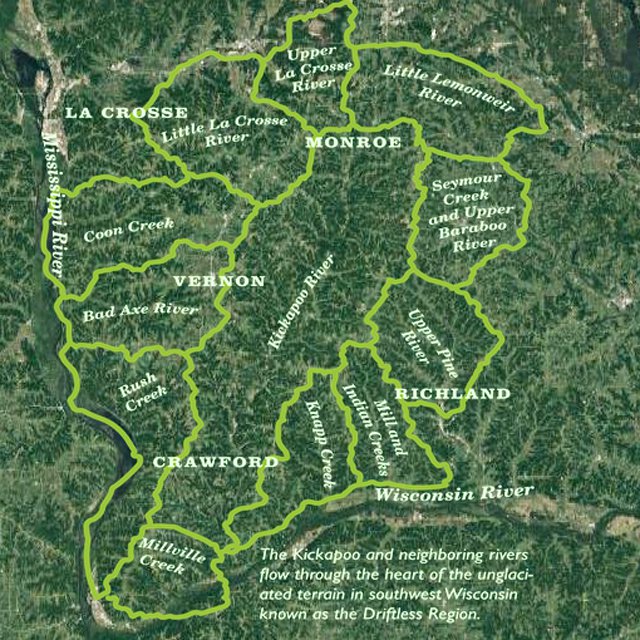DRIFTLESS - In 2014, USDA-NRCS District Conservationist for Crawford County, Karyl Fritsche, launched the county’s innovative aerial cover crop program. Fritsche worked with Crawford County Conservationist Dave Troester on the program.
Under Fritsche and Troester’s oversight, the number of acres planted in cover crops grew almost 150 percent in four years. In 2019, the two selected Adam Kramer of Black Sand Granary in Patch Grove to be their partner for transitioning the program to the private sector.
Kramer expanded the program into Grant County, and in his first season, more than doubled the acres planted. This type of public-private partnership is quite rare due to the challenges for the private sector in navigating the complexity of federal programs and requirements.
Since the program’s inception in 2014 through the 2020 growing season, total acres planted have grown from 1,855 acres to 12,003 acres. This represents a more than 650 percent increase. In 2014, as a result of the acres planted, NRCS calculates that 3,895 tons of soil were saved, the equivalent of 194 semi loads. In 2020, 25,200 tons of soil were saved, the equivalent of 1,260 semi loads.

Assessing the gains
The innovative program and its success has attracted the interest of researchers from USDA-NRCS looking for ways to understand the benefits of the practice, and demonstrate its results. Josh Bendorf of the NRCS Earth Team partnered with Fritsche and Kramer in 2020 to report on the gains from covers crops in Southwest Wisconsin. Bendorf volunteered his time for the project, while pursuing a masters degree at Iowa State.
The maps generated from the research reveal that most areas in Crawford County’s most flood-prone watershed, the Kickapoo River, showed soil organic matter (SOM) gains of between 100 tons per acre to greater than 1,000 tons per acre.

“Increases in soil organic matter mean that the enriched soil can hold ten times its weight in water,” Bendorf explained. “What this means is that the soil is capable of infiltrating more water during precipitation events and preventing the water, soil and nutrients from running off and eroding into surface waters.”
Fritsche was proud of the growth in the program she helped to launch, and observed that by 2020, the program had touched every watershed in Crawford County.
“In particular, we’ve seen very significant gains in the Kickapoo River watershed,” Fritsche said. “If we had begun this program even sooner, I think the floods we saw in 2018 would have looked very different.”
In assessing the gains in available water capacity (the capacity of the soils to infiltrate water and prevent runoff and erosion), areas in Crawford County’s Kickapoo River basin and in northwest Grant County showed overall an increased capacity of between 30-50 gallons per acre, with an increased capacity greater than 200 gallons per acre in some areas.

Carbon sequestration
Another big gain from the acres planted was in the amount of total organic carbon (TOC) that was sequestered in the soil. Overall, in Crawford County, the increased amounts of TOC sequestered ranged from greater than 1,000 tons per watershed to between 100-150 tons per watershed. Many areas in northwest Grant County saw gains of between 300-500 tons per watershed up to greater than 1,000 tons per watershed.
Carbon sequestration is the intake and storage of the element carbon. Because the soil soaks up carbon that would otherwise rise up and trap heat in the atmosphere, trees and plants such as cover crops are important players in the mitigation of the impacts of climate change.
“We estimate that as a result of the aerial cover crop program, we have seen increases of between 50-60 percent in the amount of carbon sequestered in the soils of Crawford and Grant counties,” Bendorf said. “Because organic matter is estimated to contain about 58 percent organic carbon, each percent increase in SOM results in about a 1.72 increase in sequestered carbon.”
According to the website, ‘Project Drawdown,’ “the world cannot be fed unless the soil is fed. Regenerative agriculture enhances and sustains the health of the soil by restoring its carbon content, which in turn improves productivity.
“Regenerative agricultural practices include:
• no tillage,
• diverse cover crops,
• in-farm fertility (versus external nutrients),
• no pesticides or synthetic fertilizers, and
• multiple crop rotations.
“Together, these practices increase carbon-rich soil organic matter. The result: vital microbes proliferate, roots go deeper, nutrient uptake improves, water retention increases, plants are more pest resistant, and soil fertility compounds. Farms are seeing soil carbon levels rise from a baseline of one to two percent, up to five to eight percent, over ten or more years, which can add up to 25 to 60 tons of carbon per acre.


Increased profitability
Growing cover crops and increasing soil organic matter also has great potential to reduce the amount of fertility inputs required on farms. This is because the farmer, by increasing SOM, is growing the nutrient richness of the soils on their farm. This has potential to reduce farm business costs and increase profitability.
On the low end of estimates, the nutrient values of the soils in Crawford and Grant counties in areas participating in the aerial cover crop program range from $250 to more than $5,000 per watershed. At the high end of the estimates, they range from $500 to more than $5,000 per watershed.

The nutrient value is estimated by NRCS to increase 0.1 percent per year on fields planted with overwintering cover crops. This means, with a sustained practice of planting cover crops, percentages of soil organic matter and the corresponding nutrient values in the soil, will continue to increase over time. Generally, the practice will yield more economic benefits if it is sustained for the long-term.


The watersheds in question are smaller subwatersheds (HUC-12). For instance, the Tainter Creek Watershed is a HUC-12. Each of these subwatersheds combine to make up larger watersheds, for instance the Kickapoo River, which is a HUC-8 watershed. When the amounts of available nutrients in the soil begin to be aggregated from subwatersheds to the watershed level, the amounts increase.
Bendorf estimated that a farm which sees an increase of one ton of SOM per acre would break even on their return on investment after 15 years, and would begin to see a net gain of $450 per acre after 30 years. With an increase of one-and-one-half tons of SOM per acre, the break even point would occur after 10 years, and the producer would begin to see a net gain of $450 per acre after 20 years. With an increase of two tons of SOM per acre, the break even point would occur after eight years, and the producer would begin to see a net gain of $450 per acre after 15 years.
Conclusions
As a result of their research, Fritsche and Bendorf draw the following conclusions about the gains for areas participating in Black Sand Granary’s aerial cover crop program:
• All watersheds in Crawford County have been impacted by planting of cover crops, with between 100-1,000 tons of SOM and total organic carbon added to the soil
• The increased water-holding capacity of the soil resulting from the increases in SOM is of great importance in flood-prone regions
• An added nutrient value of greater than $1,000 per watershed is common, with greater and faster increases in dollar value of the nutrients corresponding to greater and faster increases in the biomass of the soil
• Looking ahead, despite the successes already achieved, the good news, according to Bendorf and Fritsche is that there remains plenty of room for continued growth.





